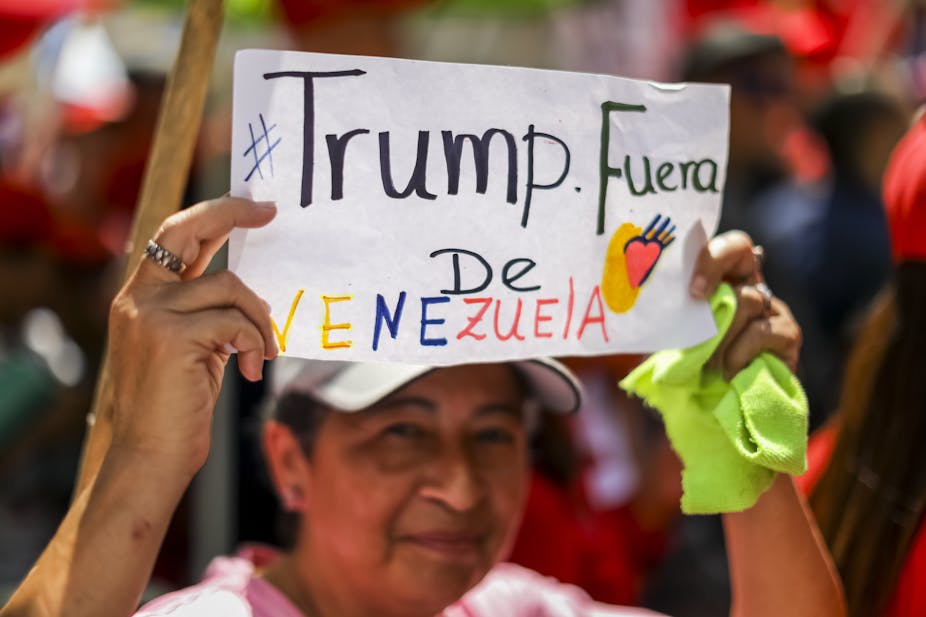Venezuela’s economic and political crisis has its roots in the decline of global oil prices and the macroeconomic incompetence of Nicolás Maduro’s increasingly autocratic government. But as hyperinflation and poverty surge, refugees flee the country and Maduro cracks down on dissent, another risk is looming on the horizon: Donald Trump is hardening his stance on the crisis, and his pronouncements are starting to sound dangerous.
In August 2017, Trump told reporters that he and his administration “have many options for Venezuela including a possible military option if necessary”. In July 2018, sources revealed that Trump had repeatedly asked aids about the feasibility of an armed invasion – and earlier in September, Trump reportedly met with current and former Venezuelan military officers to discuss plans for a military coup.
If he makes good on these words, Trump’s coercive approach could have severe implications for a crisis that has grown increasingly regional in scope – and it harkens back to the one of the ugliest chapters in the US’s relations with Latin America.
As stated by the International Crisis Group, “Venezuela’s socio-economic implosion is dragging in neighbours as hundreds of thousands of people flee the country, epidemics spread and violent crime spills over borders”. A coalition of countries in the Americas formed the Lima Group to address the political situation. Meanwhile, according to media reports, the possibility of a foreign military intervention to remove Maduro is gaining favour among Venezuelan dissidents, even including members of the army.
Suspicious minds
The US’s hawkish turn is not without precedent. The US has been at odds with Venezuela since the early 2000s, when Hugo Chávez’s socialist policies threatened US economic interests and undercut Washington’s political clout in Latin America. Chávez aimed to use the country’s oil wealth to create new institutions and integration schemes outside the US orbit, and his efforts won support from other leftist governments in the region.
In 2002, George W Bush’s administration supported a brief coup against Chávez. When Chávez was returned to power, the opposition sought to destabilise the country’s state-owned oil producer, PDVSA. The move backfired, helping Chávez assert control over the petroleum sector, which was central to the social and economic objectives of his “Bolivarian” revolution.

Yet despite its ideological animosity, the US has maintained close economic ties with Venezuela, which holds the world’s largest proven oil reserves; in fact, it was the fourth-largest supplier of petroleum imports to the US in 2017. But a steady decline in output means that for the foreseeable future, Venezuela will remain a wildcard in global oil markets, not a dependable heavyweight.
The US’s current policy cannot be attributed solely to Trump’s idiosyncrasies. At the 2018 Summit of the Americas in Peru, Vice-President Mike Pence pushed Latin American countries to further isolate Venezuela. A shakeup of Trump’s foreign policy team saw the addition of hardliners associated with the conservative Cuban-American lobby. Officials like former Secretary of State Rex Tillerson and National Security Adviser John Bolton have framed the administration’s approach to its southern neighbours with reference to the Monroe Doctrine, a school of foreign policy thought that sees the Americas as part of the US’s sphere of interests and holds that it has the right to intervene there.
Under Trump, the US has tightened its sanctions against the country, further squeezing its economy. Ostensibly targeting individual high-level officials, the rules also prohibit state-led companies from borrowing or selling assets in the US financial system, restricting Venezuela’s access to much needed dollars. The Trump administration has floated the idea of banning imports of Venezuelan crude oil while refusing to sell Venezuela refined petroleum products, which would exacerbate the country’s humanitarian problems.
Flexed muscles
Taking the long view, these moves are hardly outré by the standards of US foreign policy. Washington has a long and sordid history of intervening in the political affairs of Latin American states. Its most infamous ventures include the overthrow of democratic governments in Guatemala and Chile in 1954 and 1973 respectively, as well as an invasion to depose Panamanian dictator Manuel Noriega in 1989. The legacy of this interventionism has made Latin Americans highly attuned to any extension of US military power in the hemisphere.
Trump’s bombast, coupled with the prospect of additional sanctions, plays into Maduro’s political strategy, which depends on maintaining the support of the Venezuelan military and a shrinking section of poorer citizens still sympathetic to chavismo. Threats of invasion, empty or not, will only ratchet up socio-political instability and activate nationalist sentiment – and beyond Venezuela’s borders, they have met with pushback and condemnation from a wide swath of Latin American opinion.
The Organisation of American States has called for a peaceful resolution to the crisis through national dialogue and national reconciliation. There may be a role for responsible regional partners, but such an effort could be complicated by the strong aroma of “yanqui” imperialism (as it’s known in Latin America) emanating from a reckless White House. Polls show Trump is extremely unpopular in the region, and that Latin Americans expect relations with the US to worsen in the near term.
Trump’s endlessly scandalous domestic problems may lead him to look for a quick distraction in the form of a major foreign policy win. But a heavy-handed intervention in Venezuela wouldn’t just aggravate the already awful problems on the ground; it would backfire on the US itself in ways that could damage its relationship with Latin America for years to come.

